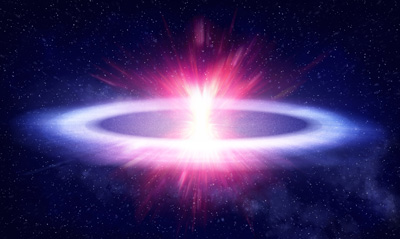(adapted from press release)
An explosion the size of our solar system has baffled scientists, because part of its shape — similar to that of an extremely flat disc — challenges everything we know about explosions in space.
The explosion was a bright Fast Blue Optical Transient (FBOT) — an extremely rare class of explosion which is much less common than other explosions such as supernovas. The first bright FBOT was discovered in 2018 and given the nickname “the cow”.
Explosions of stars in the universe are almost always spherical in shape, as the stars themselves are spherical. However, this explosion, which occurred 180 million light years away, is the most aspherical ever seen in space, with a shape like a disc emerging a few days after the initial burst was discovered. This section of the explosion may have come from material shed by the star just before it exploded.
It’s still unclear how bright FBOT explosions occur, but it’s hoped that this observation, published in Monthly Notices of the Royal Astronomical Society, will bring us closer to understanding them.
Dr Justyn Maund, lead author of the study from the University of Sheffield’s Department of Physics and Astronomy, said: “Very little is known about FBOT explosions — they just don’t behave like exploding stars should, they are too bright and they evolve too quickly. Put simply, they are weird, and this new observation makes them even weirder. Hopefully this new finding will help us shed a bit more light on them — we never thought that explosions could be this aspherical."
He went on to say that there are a few potential explanations for the flatness of the explosion. One is that the star involved in the blast may have created an equatorial disc just before it went supernova. Another explanation could be that as the star tried to go supernova the core collapsed to a black hole or neutron star, which the rest of the star fell into.
Maund added: "The levels of asymmetry recorded are a key part of understanding these mysterious explosions, and it challenges our preconceptions of how stars might explode in the Universe.”
Maund and his team used the LT's MOPTOP polarimeter to measure the polarisation of the blast, which in turn allowed them to deduce the shape of the explosion — effectively seeing something the size of our Solar System but in a galaxy 180 million light years away. They were then able to use the data to reconstruct the 3D shape of the explosion, and were able to map the edges of the blast, allowing them to see just how flat it was.
The LT's primary mirror is 2.0m in diameter, but by studying the polarisation the astronomers were able to reconstruct the shape of the explosion as if the telescope had a diameter of about 600km.
Researchers will now undertake a new survey with the international Vera Rubin Observatory in Chile, which is expected to help discover more FBOTs and further understand them.
Why "cow"?
The nickname comes from the FBOT's designation "AT2018cow". Transients are assigned a letter of the alphabet as a suffix, introducing a second character when the number of transients goes above 26 ("z"), and a third when above 676 ("zz"). The "c", "o", "w" suffix, which just happens to spell out a real word, indicates this was the 2441st transient observed that year.



